
The Basics:
- For ages 8 and up (publisher suggests 14+)
- For 2 to 8 players
- Approximately 60 minutes to complete
Geek Skills:
- Active Listening & Communication
- Counting & Math
- Logical & Critical Decision Making
- Reading
- Strategy & Tactics
- Hand/Resource Management
Learning Curve:
- Child – Easy
- Adult – Easy
Theme & Narrative:
- Go on a hunt of your dreams, but pack the right gear before you go
Endorsements:
- Gamer Geek rejected!
- Parent Geek approved!
- Child Geek approved!
Overview
American writer, Thomas Harris, said ” Problem solving is hunting. It is a savage pleasure and we are born to it.” Regardless of your own personal beliefs on the morality of hunting in the modern age, it cannot be argued that primitive man hunted to survive and was hunted in turn. Today, hunting is a past-time enjoyed by many. Now you, too, can go hunting at your gaming table.
Gut Pile, designed and self-published by Jim Clark and Tim Hanson, is comprised of 192 cards, 1 Shot die (standard six-sided die), and 1 Shot Placement die (custom four-sided die). The cards are as thick and as durable as your standard playing card and glossy. They look really nice. There is no artwork to speak of. Instead, each card depicts a photo of Alaska, be it the scenery, the wildlife, people, places, or equipment found in the rugged wilderness. Not included with the game, but necessary to play, is a pen or pencil and a piece of paper to record players’ scores.
Preparing for the Big Hunt
To set up the game, first remove all the reference cards from the deck and set them aside. Then shuffle the remaining deck of cards.
Second, deal each player 4 cards, face-down. Players should keep their cards hidden from opponents until played.
Third, place the remaining deck of cards face-down in the middle of the playing area and within easy reach of all the players. This is the draw deck for the duration of the game. Leave room for a discard pile.
That’s it for game set up. Time to bag a buck or two.
Hunting Grounds
Gut Pile is played in turns. A player’s turn is summarized here.
Step 1: Draw Cards
The first thing a player does on their turn is take 2 cards from the draw deck, 2 cards from the discard pile, or 1 card from each, adding them to their hand. The only exception to this rule is if an Action card has been played to the discard pile. In which case, the player must take cards from the draw deck.
Step 2: Go Hunting
The player now plays 1 card from their hand, face-up, in front of them. There are seven different types of cards that can be played.
Weapon Card
The Weapon card represents the hunting weapon being used. It can be rather primitive (a spear, for example) or modern (a high-powered rifle). The bigger advantage the weapon gives the hunter over the prey, the less points the player will possibly earn. However, a more primitive weapon is harder to use and will not be as successful in the hunt.
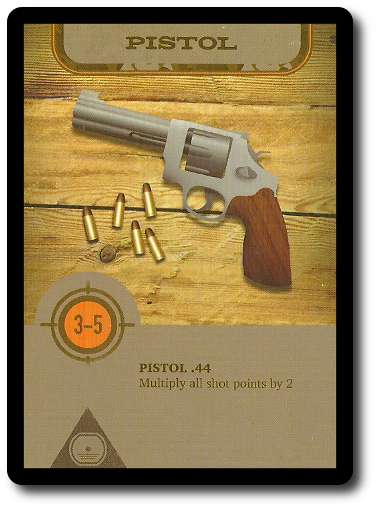
Gear Card
Gear cards provide the player with bonuses and can even reduce negative card effects.
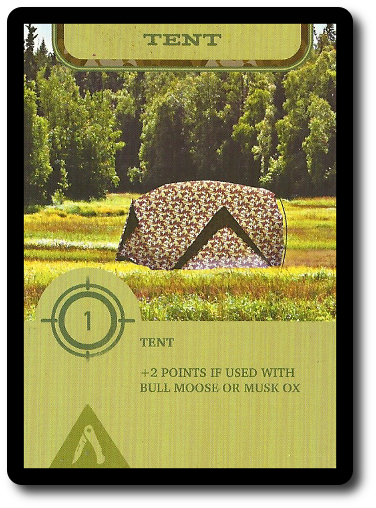
Transportation Card
Transportation cards represent the vehicles used (or lack thereof) to get to the hunting grounds. The better the transportation, the deeper into the wilderness a hunter can go.
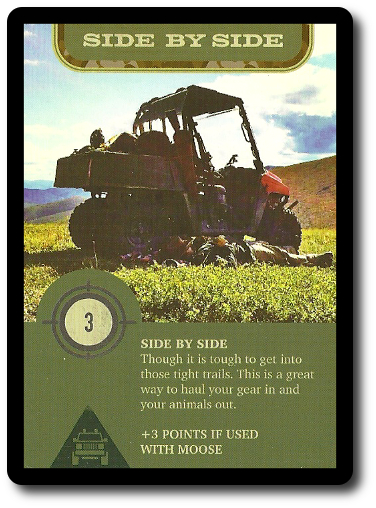
Terrain Card
Terrain cards represent the area in which the hunting grounds are located. They also detail various restrictions and benefits that will need to be followed for the hunt.
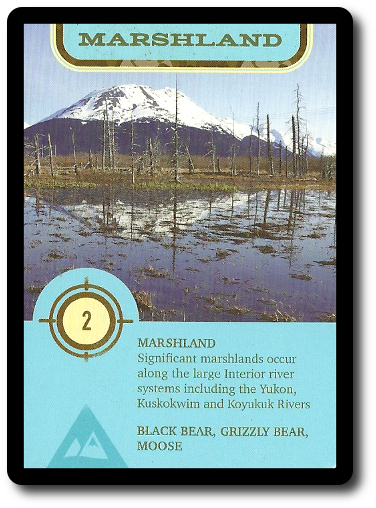
Animal Card
Animal cards represent the various wild game the player can expect to encounter in the hunting grounds. Animal cards come in two different types. These are tagged and un-tagged. Un-tagged are much more wild and difficult to hunt, but provide a much bigger bonus. But be careful. Hunting un-tagged animals is illegal and can land the player in the hurt bag if they are caught by the State Trooper or Park Ranger.

I should also note that Gut Pile does not condone or suggest that players should hunt illegally in real life.
Action Card
Action cards are used to hinder the progress and ruin the hunt of opponents. They can normally only be played to the opponent on the player’s immediate left or right, but a few Action cards allow you to play them to whomever the player wishes.
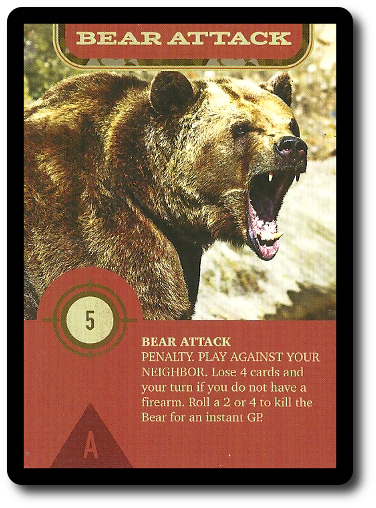
Bonus Card
Bonus cards are just that: additional cards that can be played to the hunt.
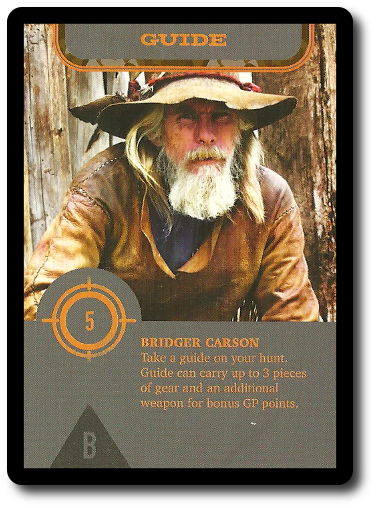
Step 3: Take a Shot
If a player has a Weapon, Gear, Transportation, Terrain, and Animal card in play, they can attempt to take a shot at the animal and bag it for a trophy. To attempt a shot at an Animal card, the player rolls the Shot and Shot Placement dice. The Weapon card will have a number range in which the die value must fall in order for the roll to be successful. The Shot Placement die determines where the player hit the animal (rear, lung, heart, etc.).
If the player hit the animal, they now add up the bonus points from the Shot Placement die and any provided by the Terrain, Equipment, Bonus, and Gear cards. At anytime during the hunt, opponents can play Action cards making things more difficult. If the hunt is still successful, the player collects the points and records them.
If the hunt is not successful, the Animal card is discarded and no points are earned.
Step 4: Discard
The last thing a player does on their turn is discard 1 card from their hand to the discard pile, face-up.
Ending the Hunt
The game continues as described above until 1 player has earned 3 Gut Piles (3 successful hunts). All players now compare their points. The player with the most points wins the game. This means a player who only hunted once, but bagged a really impressive trophy, could win the game based on points alone.
To learn more about Gut Pile, visit the game’s web page.
Final Word
 The Child Geeks liked the idea of the game and the different animals. They quickly caught on to the benefits of planning a big expedition and bringing along as much gear and transportation as possible. They also continually ended the game way too early. In Gut Pile, players have the ability to control when the game ends. All it takes is ending 3 successful hunts. But successful hunts don’t win the game, points do. According to one Child Geek, “It can be really frustrating when another player is obviously just attempting to finish the game as fast as they can. They won’t always win, but it makes the game a lot more stressful.” Another Child Geek said, “What I like most is being able to hunt for the animals that I think are the best and leave the rest. I don’t want to hunt squirrels. I want to hunt bears!” When the hunts were over and the points on the antlers counted, the Child Geeks voted to approve Gut Pile. They also all agreed that the name of the game was the grossest thing they had ever heard.
The Child Geeks liked the idea of the game and the different animals. They quickly caught on to the benefits of planning a big expedition and bringing along as much gear and transportation as possible. They also continually ended the game way too early. In Gut Pile, players have the ability to control when the game ends. All it takes is ending 3 successful hunts. But successful hunts don’t win the game, points do. According to one Child Geek, “It can be really frustrating when another player is obviously just attempting to finish the game as fast as they can. They won’t always win, but it makes the game a lot more stressful.” Another Child Geek said, “What I like most is being able to hunt for the animals that I think are the best and leave the rest. I don’t want to hunt squirrels. I want to hunt bears!” When the hunts were over and the points on the antlers counted, the Child Geeks voted to approve Gut Pile. They also all agreed that the name of the game was the grossest thing they had ever heard.
 The Parent Geeks, especially those who were avid hunters, very much enjoyed the game, finding it to be a fun and fair representation of all the planning one must do in order to go on a hunting expedition. According to one Parent Geek, “I think my favorite part is the actual shot. Even if you plan everything ahead, you can still miss. Nothing hurts more than watching a 40-point buck bound off into the thicket because you are a crappy shot.” I don’t believe a 40-point buck exists, but the Parent Geek’s example is valid. Another Parent Geek said, “A fun little game. I like how many combos you can rack up and the number of points you can earn can be huge if you take your time.” Not all the Parent Geeks found the game to be fun, mostly because they weren’t hunters, but none of them found the game to be particularly bad, either. The end result was a full level of approval from the Parent Geeks.
The Parent Geeks, especially those who were avid hunters, very much enjoyed the game, finding it to be a fun and fair representation of all the planning one must do in order to go on a hunting expedition. According to one Parent Geek, “I think my favorite part is the actual shot. Even if you plan everything ahead, you can still miss. Nothing hurts more than watching a 40-point buck bound off into the thicket because you are a crappy shot.” I don’t believe a 40-point buck exists, but the Parent Geek’s example is valid. Another Parent Geek said, “A fun little game. I like how many combos you can rack up and the number of points you can earn can be huge if you take your time.” Not all the Parent Geeks found the game to be fun, mostly because they weren’t hunters, but none of them found the game to be particularly bad, either. The end result was a full level of approval from the Parent Geeks.
 The Gamer Geeks found Gut Pile to be boring. According to one Gamer Geek, “It’s the same thing every time. I play cards to increase my points and then randomly determine if my hard work was worth the effort.” The die rolling was not well-received, as the Gamer Geeks found it confusing and frustrating to put so much control into the player’s hands and then have it yanked away at the last possible moment when it meant the most to the player’s chances of victory. As one Gamer Geek put it, “The game is a big tease. It lets you set up this incredible combo and then it all comes down to a stupid random dice roll to determine if you can even score the points you worked on. It’s like building your own house and then being told you can’t move in.” Needless to say, Gut Pile didn’t get many Gamer Geek friends, even those who were hunters didn’t care for the game. The end result was a rejection from the gaming elitists.
The Gamer Geeks found Gut Pile to be boring. According to one Gamer Geek, “It’s the same thing every time. I play cards to increase my points and then randomly determine if my hard work was worth the effort.” The die rolling was not well-received, as the Gamer Geeks found it confusing and frustrating to put so much control into the player’s hands and then have it yanked away at the last possible moment when it meant the most to the player’s chances of victory. As one Gamer Geek put it, “The game is a big tease. It lets you set up this incredible combo and then it all comes down to a stupid random dice roll to determine if you can even score the points you worked on. It’s like building your own house and then being told you can’t move in.” Needless to say, Gut Pile didn’t get many Gamer Geek friends, even those who were hunters didn’t care for the game. The end result was a rejection from the gaming elitists.
 Gut Pile is a game for an individual who is a hunter and a casual gamer. It falls well short of being an elitists game and has a bit too much complexity and combos to be a game a non-gamer would enjoy fully. It most certainly falls into a niche which will make it difficult to find players, but should be enjoyed to different degrees by everyone who plays it. It should also be noted that a player need not be a hunter to appreciate the game, but if they don’t care for hunting to begin with, then Gut Pile will not be well received.
Gut Pile is a game for an individual who is a hunter and a casual gamer. It falls well short of being an elitists game and has a bit too much complexity and combos to be a game a non-gamer would enjoy fully. It most certainly falls into a niche which will make it difficult to find players, but should be enjoyed to different degrees by everyone who plays it. It should also be noted that a player need not be a hunter to appreciate the game, but if they don’t care for hunting to begin with, then Gut Pile will not be well received.
I found the game to be OK at best. I liked the many different combos and the ability to control the game’s length of play. I also enjoyed how a player could risk taking more time to set up the perfect hunt in order to score big points, but doing so made them a big target for others. After all, you can see what opponents are up to right from the start. What I didn’t care for were the rules and the game’s simplistic play. It can get repetitive and the only big payoff comes at the end when you roll the die. Even then, your hard work could fall to the side since you didn’t roll within the right range. Very frustrating and true to life if the player was in a real hunt. Sometimes all the preparation in the world doesn’t secure a trophy buck.
If you are a hunter and a gamer, then Gut Pile is sure to be a hit. It lets you hunt at home and dream of big trips in the wilderness that would normally take up too much money and time to even attempt. For everyone else, there are aspects of Gut Pile to be enjoyed, but I doubt the game as a whole will tickle your fancy. Either way, go hunt down this game and give it a try for yourself. Who knows, you might get buck fever or get skunked.
This game was given to Father Geek as a review copy. Father Geek was not paid, bribed, wined, dined, or threatened in vain hopes of influencing this review. Such is the statuesque and legendary integrity of Father Geek.



